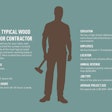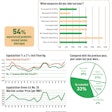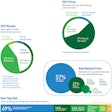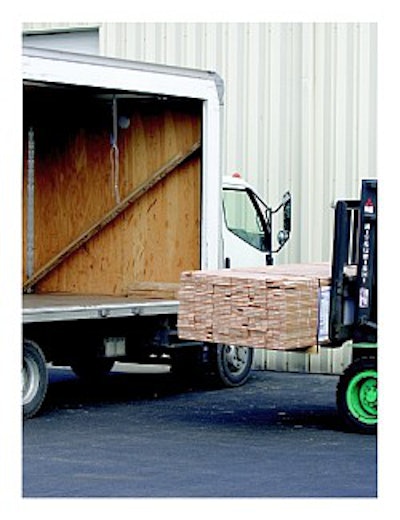
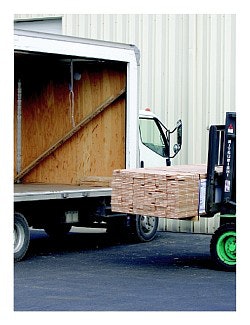
"Rumors of my death have been greatly exaggerated." — Mark Twain
For years, industry observers have discussed the demise of the distributor. They predicted that as the industry matured, technology advanced and the global business world shrunk, the distributor would become a dinosaur.
However, those predictions have proved to be unfounded. Far from disappearing from the industry, distributors have continued to play a vital role in the growing wood flooring industry.
To find out how wood flooring distributors have adapted to the changing industry, Hardwood Floors spoke with distributors across the country and found that far from cowering in fear, distributors are confidently changing with the times and preparing for the future.
A Crowded Market
Across the country, many distributors report that business is good but sometimes inconsistent. The gradual slowing of the housing market (see "Housing Market Index" chart on page 38) has slowed the wood flooring business for some distributors, and others also see that the remodeling market hasn't picked up the slack as it usually does when new home sales slow down.
Interest rates have stayed at historically low levels but are creeping up. Higher home equity rates, combined with the fact that people accumulated large amounts of debt during recent years when interest rates were at rock-bottom lows, have combined to put a damper on some remodeling markets.
As the industry has flourished in recent years, there are more distributors than ever before, whether they are existing distributors moving into new geographic markets or new companies entirely. Any slowdown creates a challenge in this crowded market.
"I think business has slowed a little; manufacturers have started building up inventories and they're trying to move product," says Tony Benvenuti, president/owner at Auburn, Mass.-based distributor Wood Pro Inc. "Distributors are trying to regain business and are dropping prices. We're seeing a major competitive situation on margins. We're really getting squeezed."
To make things more complicated, lines of traditional distribution channels are blurring. The days when manufacturers would only sell to established wood flooring or floor covering distributors seem to be fading away, especially as new manufacturers and importers enter the wood flooring market every day. As the market becomes more crowded, suppliers look for any channel possible to sell their products.
"I think everyone's becoming a distributor; that's a huge challenge," says Wayne Cotton, president at Pompano Beach, Fla.-based wood flooring distributor Design Flooring Distributors Inc., which specializes in selling high-end products to floor covering dealers. "We've got some of the bigger retailers that are starting to act as distributors and basically bypassing us. What we saw at Surfaces was that anyone on the first floor was willing to make you a distributor. I think the distribution channel is whoever has money," he says.
Some manufacturers don't need any distribution at all. Bob Nygaard, vice president at Jamaica, N.Y.-based distributor Olson Floor Supply, says, "Everybody's trying to figure out how to go direct with their materials, but the problem they have is they don't know how to get paid!"
In his area, Rick Holden, executive vice president at Willow Grove, Pa.-based distributor Derr Flooring Company, sees several smaller niche-type manufacturers selling directly to retailers or consumers.
Involved Consumers
The Internet is a big factor in allowing consumers to connect with suppliers. In general, information online has led to homeowners who are vastly more knowledgeable about wood flooring than they were even five years ago.
"In some instances, I've seen the homeowner be more educated than the contractor," says Mike Glavin, CEO at Conshohocken, Pa.-based distributor Philadelphia Floor Store Inc., adding that those situations emphasize how valuable a legitimate distributor can be in helping educate the contractor or retailer.
Nygaard says that just as consumers now shop for cars on the Internet and know exactly how much they should cost, oftentimes consumers call him, knowing exactly what product they want and how much they think they should pay for it.
Jim Duffey, vice president and general manager at Denver-based distributor Palo Duro Hardwoods Inc., has received calls from consumers looking for solutions to problems with wood flooring they purchased over the Internet. "They were displeased with not being able to get additional product, not being able to get the trim pieces, not being able to get the warranty information," he says. "It's easy to buy, but hard to live with."
"These are installed products—there's a lot of value that's added to the product once it comes out of the truck or the box," points out David Rowe, vice president and general manager at Denverbased distributor Denver Hardwood Company. "Even a less-expensive wood floor is still a high-dollar item in the customer's home."
Today's savvy consumers have much greater awareness of wood flooring in general. From the Internet to remodeling shows, homeowners are seeking out wood flooring. "The average consumer is much more willing to take on a DIY project now than they would have 10 years ago, whatever it is, whether flooring or something else," says John Pankratz, materials manager for Seattlebased distributor Kelly-Goodwin Company. "I think there's been a lot more awareness of hardwood floors, and because of that … we all enjoy more business."
Although many customers are more educated about wood floors than they used to be, the influx of new buyers results in many who have unrealistic expectations about their wood floors. As the market grows, it's crucial for distributors to take the lead in educating their customers, who in turn need to educate the consumers having the floors installed.
At Plymouth, Wis.-based FSC Flooring Distributors Inc., which specializes in selling to floor covering dealers, President/Co-Owner Tim Flagstad says that "traditionally, hardwood is the least understood product line in every floor covering store."
Tim Ryan, corporate manager for wood and laminate at Mesa, Ariz.-based floor covering distributor Longust Distributing Inc., recalls a recent case where the customer was unhappy because the family's large dog was damaging the brand-new walnut floor. In such a case, the customer should have been warned about the potential for the soft wood to be damaged, but she wasn't. As the wood flooring market grows, such examples are common, Ryan says. "When they spent $13,000 and didn't get what they expected, it leaves a really bad taste in their mouth," he adds.
Additionally, Ryan says he tries to explain the realities of prefinished wood flooring warranties to consumers up front. "We try to tell people that these finishes will ugly out before they wear out, and the warranty doesn't cover that, but the consumers think that's being slimy," he says, adding that he can understand why some consumers feel misled by today's warranties.
Plethora of Products
It's no surprise that consumers may feel confused about their options in the wood flooring industry. They aren't the only ones. Distributors these days are overwhelmed by the myriad companies and products in the marketplace.
"One of the biggest challenges I have right now is trying to keep up with all the new products being offered out in the industry," Kelly-Goodwin's Pankratz says. People these days are demanding more species, more grades and more widths in every type of flooring imaginable. "There are so many more things to look at, and it's a challenge to stock them and deliver them on time," he says.
"We get inundated with new suppliers coming in, but I really spend a lot of time researching those guys and sitting down with potential suppliers to see if they fit," Wood Pro's Benvenuti says, adding that he tries to increase his business with existing suppliers rather than take on new lines whenever possible.
From coast to coast, a clear trend is that prefinished flooring continues to take market share from unfinished products. The reasons are legion: finishes that are continually improving in both durability and appearance, improved milling, a vast selection of colors, better marketing and, of course, the simplicity and speed of installation.
Even the most traditional sand-and-finish markets, from Seattle to Denver to New York, are seeing a continued surge in prefinished flooring's popularity. Distributors that have never carried prefinished flooring before are taking on some prefinished lines, and contractors who vowed to never install it are finding themselves doing just that.
"Some of those sand-and-finish guys who said they're only going to do unfinished are installing prefinished floors now," says Glenn Lanctot, salesperson at Auburn Hills, Mich.-based distributor Premium Hardwoods Inc. "They hate them, but they're installing them because they're turning dollars."
From a profitability standpoint, prefinished flooring can be lucrative for both the distributor and the retailer or contractor. "The margin opportunities for unfinished are not as lucrative as maybe the prefinished side of the business might be," Flagstad says. "With prefinished, there's more of a value story there."
The finishes, warranties and easy installation are compelling, Derr's Holden says, adding that an increasing amount of slab construction, such as retirement condos, contribute to the increased use of prefinished products. In addition, he doesn't see other competing segments of the industry answering the marketing power of the prefinished products. "The unfinished flooring manufacturers and finish manufacturers have not been able to come up with a cohesive marketing plan to address that to the consumer," Holden says.
Those traditional markets that are seeing the appeal of prefinished flooring are also succumbing to the trends that have been going strong in the industry for several years now. Distributor BlakeStevens has four locations throughout Wisconsin, typically a conservative market, but, "For our area, it seems like the trend is darker colors, wider widths and character grades. We're still seeing a pretty strong interest in hand-scraped flooring," says company President Steve Schoonover.
Likewise, in Detroit, Premium's Lanctot says he's selling "everything but 2 1/4 , which in Detroit here is the mainstay."
Exotic species continue to be more prevalent, and distressed products offer many advantages for the consumer and the seller, including the fact that slight milling variances and daily wear tend to become part of the character of the floor instead of a callback.
Decreasing demand for standard unfinished oak strip products combined with an ever-increasing number of suppliers have helped push down strip prices. With unfinished strip prices at extremely low levels, exotics and the prefinished floors are products that do offer the distributor, contractor and retailer an opportunity to make a decent margin.
"I think the exotics and hand-scraped products have really been the difference maker in hardwood for us," Longust's Ryan says. "It's pushed the average costs of the floor up, and there's a value there for the consumer."
"People traditionally wouldn't pay $10 a square foot for a prefinished wood floor, and today they will," Cotton says. "That's directly related to home prices going up and people having to put more into homes to distinguish them as a higher-end product." People are realizing that flooring can be a fashion statement instead of just a utilitarian object, he says.
Palo Duro's Duffey agrees. "No longer is a textured floor what the buyer is looking for like they were three or four years ago," he says. "They truly are becoming more discerning, and they want a textured floor that has a uniqueness to it."
Not only are consumers choosing more expensive products, they are also having a greater amount installed. "It's very regular that we deliver 4,000 square feet to one home," Philadelphia Floor Store's Glavin says, adding that as the size of the projects increase, the risk for failure is even greater, leading his company to stress technical training for its customers more than ever.
The Asian Influence
One of the most drastic changes in recent years is the influx of imported products, especially those from Asian markets. The topic is sure to create a heated discussion faster than any other in the wood flooring industry, but most distributors have the practical attitude that these products are now a part of the market and are here to stay. Distributors in the western half of the country seem more likely to handle the products directly.
"There are lots of distributors that are being set up by these offshore manufacturers," says Jeff Hamar, president at Santa Fe Springs, Calif.-based distributor Galleher Hardwood Co., which handles many imported products. "I think it's happening in certain regions at a much faster rate than other parts, but there's nothing to suggest it won't move across the country," he says.
"I don't think they can be ignored," Kelly-Goodwin's Pankratz says. "I think you have to be careful with the quality of the product. I'm comfortable with what we are handling, but I'm wary of any new products that come along," he says, adding that Asian manufacturers often tend to overstate quality.
At Longust, Ryan says he sees a place for the products in the marketplace. He uses the analogy of comparing Chevys and Cadillacs. "If all you have is a Cadillac, and domestically produced products—pricewise—are considered a Cadillac, and you have a legitimate Chevrolet buyer, you have a problem," he says.
That said, Ryan also sees drawbacks to the amount of product flooding the market from what he calls "quick-draw" agents. "They really hurt the integrity of the channel, because they'll sell bad product unbelievably cheap, and then when claims come along, they're nowhere to be found," he says.
Galleher's Hamar agrees. "There are all these new people in the industry. Four years ago they were selling mortgages or life insurance, and now they're flooring distributors," he says, adding that they carry almost no overhead costs to running their businesses.
However, product quality from many Asian manufacturers is getting better, Hamar says. Additionally, whereas many Chinese manufacturers tried to enter the North American market with shiny finishes on Chinese species, they are now figuring out the styles that consumers here prefer, he adds.
For many distributors, sourcing product from Asia may be more of a hassle than they are willing to handle. "Sourcing in China is not as simple as making a mill trip in North America," says Denver Hardwood's Rowe, who has done it. "You need to go over there with people who are knowledgeable with regard to the culture and manufacturing entities, and you need someone who can break down the language barrier."
General floor covering distributors with experience in importing other products have an advantage in that regard. At Longust, the company has been importing tile for years. "The president of our company has been sourcing out foreign manufacturing for a decade or better, so we aren't exactly new at trying to look overseas to find manufacturers," Ryan says.
Distributors who don't want to take on the hassles or risks of dealing directly with Asian manufacturers still have options to source that product. Instead of importing the products directly, Mandeville, La.-based Southeast Hardwood Flooring Distributors Inc. handles those products through its American manufacturers who source it from Asia.
"I don't know how you can't have that and be competitive. I think that's a trend that will continue and increase," says Frank Macaluso, the company's sales and marketing manager.
Likewise, Cotton's Design Flooring Distributors also buys from American manufacturers who private-label Asian imports. "That gives us some type of security as far as the quality and the warranty," he says.
In many cases, prices throughout the market have already adjusted to compete with Asian imports. Lower domestic lumber costs have helped manufacturers here lower prices, as well.
"On the domestic front, prices on many products have come down, especially in the solid prefinished floors," Denver Hardwood's Rowe says. "That playing field has leveled out quite a bit." Rowe doesn't see that there is any room for prices from the Asian market to drop further. "There are some significant transportation costs, and the pipeline is so long, such that planning is difficult with regard to appropriate inventory levels and making purchasing decisions," he says.
Al Maghes, vice president of sales and marketing at Ferndale, Mich.-based Erickson's Flooring & Supply, also sees that there are plenty of domestic bargains. "We buy no product directly from the Chinese, because I see as good a deal here. Many Americans don't look at the true cost of buying from that source," he says, citing the long lead times and other logistical problems.
"The U.S. manufacturers are offering engineered products with similar or better quality at very competitive pricing to the Chinese," Derr's Holden adds.
Price and other hidden costs aren't the only factors to weigh when considering the Asian imports. Many distributors are still distrustful of the product quality, especially when exposed to extreme moisture swings common in many areas of the U.S. Others cite reports that a substantial percentage of Chinese products are produced with lumber logged illegally as a concern. And, others still feel strongly that people should "buy American."
These days, that's easier said than done.
"My take on Chinese product is that it's a free market. If people are willing to buy it, then it deserves to be in the marketplace," Philadelphia Floor Store's Glavin says. "I'm a firm believer in 'buy American,' but that's a hard thing to do, from every household product to cars and trucks."
One area where distributors think American products are firmly entrenched is solid unfinished strip flooring, and they see current low prices on that product as a result of dynamics in the domestic market, not pressure from competing imports. "I don't think they [Asian manufacturers] can do much with unfinished strip," Kelly-Goodwin's Pankratz says. "They still make a pretty darn good product over here, and it's pretty inexpensive." Additionally, many areas of the U.S. are firmly entrenched red oak markets, making the "Chinese white oak" aesthetic unappealing.
Daily Dynamics
While distributors sort through their options for domestic and foreign products, they're also concerned about trying to contain the everyday costs of doing business. In particular, transportation costs are a big concern. As fuel costs in 2005 spiked and then relented somewhat, distributors saw freight carriers' charges go up with the increases in fuel costs—but then they never came back down. Now, distributors fear that their freight costs have been fixed at these higher levels.
Especially in such a competitive environment, the costs are too great to pass them on entirely to their customers, distributors say. "We've tried to absorb a lot of that cost," Blake Stevens' Schoonover says. "Things have settled down a bit, but diesel is still expensive."
Denver Hardwood's Rowe concurs that passing along some of the costs has been difficult. "These are real costs, and we're having difficulty with some dealers and some contractors getting them to understand and accept that these are real costs."
Besides fuel costs, distributors face the same challenges that most other American businesses today face—how to provide employees with benefits and customers with service yet still be competitive.
"Every day we have to look at ways of how we can save money without cutting service," Design Flooring Distributor's Cotton says. "We do that a lot through technology."
Although distributors look for ways to cut the fat in business operations, the fact is that these days, most of them are already lean and trim.
"We work with productivity issues on an ongoing basis and realize gains in certain areas," Rowe says. "However, over the last several years, any excesses that existed in the cost structure of a distributor business either have been filtered out, or those distributors are no longer in business."
The Bottom Line
While distributors try to make adjustments to curb their day-to-day costs, they're also adjusting to new dynamics with their suppliers. Whereas the wood flooring industry traditionally prided itself on its personal relationships, as the industry has grown and matured, bottom-line corporate mentalities often dominate.
"It's becoming less and less important that there is a relationship, and basically, it's all about the numbers," Cotton says.
Maghes at Erickson's Flooring & Supply says that he had one vendor tell him, "You're only as good as your last P.O."
Such anecdotes are more common than not these days, but that doesn't mean that distributors are simply rolling over. "I think some suppliers have taken the 90-degree turn and gone to the big corporate mentality. We as a distributor try to avoid those types of suppliers," Palo Duro's Duffey says.
Likewise, Derr's Holden says his family-owned business still strives to use suppliers with a like-minded philosophy. "The vast majority of our suppliers we still deal with on a verbal agreement and a handshake; we'll do the best we can to sell their products and they'll do the best they can to get us the right products," he says. However, the increasingly corporate mentality is unavoidable. It isn't bad, it's just different, he says, adding that "it still comes down to us performing."
Performing while adjusting to change is essential for today's distributors. Their businesses are transforming faster than they ever have with regards to products, suppliers, customers and technology, and they have to change along with the times. However, most distributors still feel it all comes down to performing their basic roles well. And, it's those fundamnetal roles that will make distributors an essential part of the wood flooring industry in years to come.
Erickson's Maghes says that if a distributor adds value to its products and employs a sound business model, that's the basis for success, now and in the future. "Technology and globalization have increased the pace at breakneck speed, but at the end of the day, the customer still wants the fundamentals performed and performed well," he says.
Rowe agrees. "There are functions a distributor performs that somebody has to do; there are costs associated with that," he says. "I think because of that, distributors will continue to do well and thrive—if they pay attention to the business and take care of their customers."
After the Storm

More than six months after the devastating hurricanes Katrina and Rita, the Gulf Coast still has a long way to go to recover from the physical and emotional destruction wrought by the storms. In New Orleans, many parts of the city still appear as if the hurricanes hit only recently, but other areas have moved on with recovery. Amid the chaos and uncertainty that still reign, wood flooring businesses are adjusting to the new realities and moving forward.
In the city of New Orleans, there still is no agreement on a master plan for reconstruction. John Troendle, president of distributor Crescent Hardwood Supply in New Orleans, says that the mayoral election this month will be the decisive factor in settling on a plan— residents will vote for the candidate with the plan they like, and the city will finally be able to move forward.
"Until we get a plan, you're not going to see the vast majority of the people start to rebuild, because they're talking about bulldozing complete sections of the city," Troendle says.
In addition to changing the neighborhoods in the city, there is also talk that new construction in many areas will be different. Whereas houses in most of the area have always been built on-grade on concrete slabs, some new houses may be required to be raised 8 to 10 feet using a raised pier-and-beam structure.
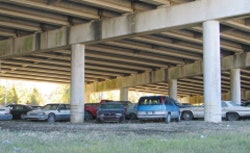
Many people are simply not interested in returning to the city. Gregg Mancuso, president and co-owner of Mandeville, La.-based contracting company Wood Floor Finishers and distributor Southeast Hardwood Flooring Distributors, lost his house, which was a mile away from the now-notorious 17 th Street Canal. He has since moved to the North Shore. "Even if they said, 'Come back in, we'll insure you and the levies will be great,' I don't trust it and I don't believe it. I don't want to go through this ever again from a personal perspective," he says, echoing the sentiments of many former residents.
Despite delays and disinterest in rebuilding in some parts of the city, business for wood flooring contractors and distributors is booming, especially in surrounding areas and the many neighborhoods of New Orleans that were not badly flooded. Although many people are still waiting for insurance checks, those who have the finances to pay for repairs or construction are doing so.
"Builders who are pretty astute and had the financial wherewithal and resources went out and purchased every lot that was available and started building on it," Mancuso says. "Now all those houses are starting to get ready for wood flooring."
At Southeast, business is "just unbelievable," says Sales and Marketing Manager Frank Macaluso. Anything related to wood flooring is flying out the door, he says.
"We've probably got 50 percent more wood flooring contractors now than we had before the storm," Troendle says. Mancuso says that his contracting company had 14 crews prior to the hurricanes but now has only six left. Most of the workers started their own wood flooring companies. In addition to the many new startups in the area, contractors also have come in from nearby states such as Florida and Texas.
Although business is booming, day-to-day operations are still far from normal. Mail in the city is still a major problem. As of the beginning of March, Crescent was still receiving only about 3 days of mail per week, and Troendle was looking into using e-statements and e-invoicing. Companies have also struggled with labor shortages.
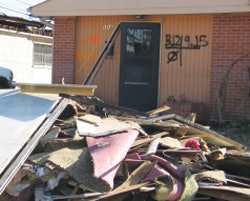
"As we opened back up, I started losing about one warehouse person a week because they were ripping out sheetrock for 25 bucks an hour," Troendle says. Drivers are still nearly impossible to find, he adds, because FEMA is paying drivers $25 an hour, whereas pre-hurricane, they would typically make $12 to $15 per hour. To try to retain employees, Troendle says his company implemented temporary pay raises.
"We're having to pay subs double what we were paying in-house crews," Mancuso says, adding that workers comp and general liability insurance have increased, and material costs have increased. Additionally, the business has to recover from the two months of no revenue.
Some workers simply couldn't handle the strain of training new employees and dealing with post-hurricane customers, Mancuso says. With the stress of the entire situation, customers' tempers are short, and he says that's a daily challenge. Additionally, working conditions are still far from normal. "We can't get a dumpster to a job site, and people don't understand why we can't remove the trash," he says. "We're limited to putting it on the front lawn."
Customers are desperate to get their floors done as quickly as possible, and jobs are going for a premium. To turn as many jobs as they can, many contractors are pushing prefinished floors, Troendle says, and even some customers who don't like prefinished floors are buying it just so they can get their homes back to normal in as short a time as possible. Macaluso says he sees customers buying the whole gamut of floors, with many using insurance money to buy high-end products they normally wouldn't be able to afford.
Jobs right now are booked for months at a time. No one sees an end to the boom for years to come, but they are keeping the eventual slowdown in mind. Mancuso predicts an "extreme belt tightening" when the construction boom ends. "You know this won't last. There's an end to this at some point, and we just can't wait to get to that end and achieve some sort of pre-storm normalcy," Mancuso says. —K.M.W.
The Year in Numbers
In January, Hardwood Floors surveyed distributors and contractors to find out how they did in 2005 and which products they were using. Approximately 91 percent of contractors who responded specialized in wood flooring; while 85 percent of distributor respondents were wood flooring specialists. Here's what they told us:
Where They Buy
Of the contractors surveyed (more than one answer possible) ...
85% buy from specialty wood flooring distributors
23% buy from general floor covering distributors
18% buy from a big-box store
21% buy direct from manufacturers
At a big-box store, contractors say they are most likely to buy (in order of likelihood):
- installation tools
- adhesives
- finish
- wood flooring (tied) sanding equipment (tied)
- abrasives
Contractors' Business in 2005 ...

In 2004...
• 47 percent of contractors indicated that business increased
• 43 percent stayed the same
• 10 percent decreased
Distributors' Business in 2005

In 2004 ...
• 77 percent of distributors indicated that business increased
• 2 percent decreased
• 21 percent stayed the same
Alternate Outlets?
Of the distributors surveyed ...
27% said their business has been affected by bigbox stores such as Home Depot and Lowe's
73% said they have not been affected by big boxes
19% sell some product online Of the distributors surveyed ...
Peddling Plastic?
Of the distributors surveyed ...
39% sell a laminate (Pergo-type) product
61% do not
64% expect laminate to grow
36% do not
Finish Used by Contractors

In 2004, contractors said ...
• 51% oil-modified
• 38% water-based
• 6% moisture cure
• 4% conversion varnish
• 1% wax
Finish Sold by Distributors

In 2004, distributors said ...
• 52% oil-modified
• 36% water-based
• 5% conversion varnish
• 7% moisture cure
• <1% wax
Species Installed by Contractors

The contractor numbers in 2004 were ....
• 48% red oak
• 20% white oak
• 10% maple
• 7% other domestics (cherry, ash, birch, beech)
• 6% Brazilian cherry
• 6% other exotic species
• 3% Heart pine
Species Sold by Distributors

The distributor numbers in 2004 were ....
• 36% red oak
• 21% white oak
• 13% other exotic species
• 11% maple
• 8% Brazilian cherry
• 7% other domestics (cherry, ash, birch, beech)
• 4% Heart pine
Contractors Are Installing ...

Contractor numbers in 2004 were ...
• 66% unfinished solid
• 23% prefinished solid
• 10% prefinished engineered
• 1% unfinished engineered
Distributors Are Selling ...

Distributor numbers in 2004 were ...
• 48% unfinished solid
• 26% prefinished solid
• 24% prefinished engineered
• 2% unfinished engineered
How Contractors Spend Their Time
Dividing Their Time ...

In 2004, contractors divided their business, on average ...
• 53% sanding/finishing/refinishing
• 47% wood flooring installation
Something Old, Something New

In 2004, contractors divided their business, on average ...
• 63% remodeling
• 37% new home construction
What's Underneath

In 2004, contractors installed over ...
• 50% basement
• 31% crawl space
• 19% slab
























